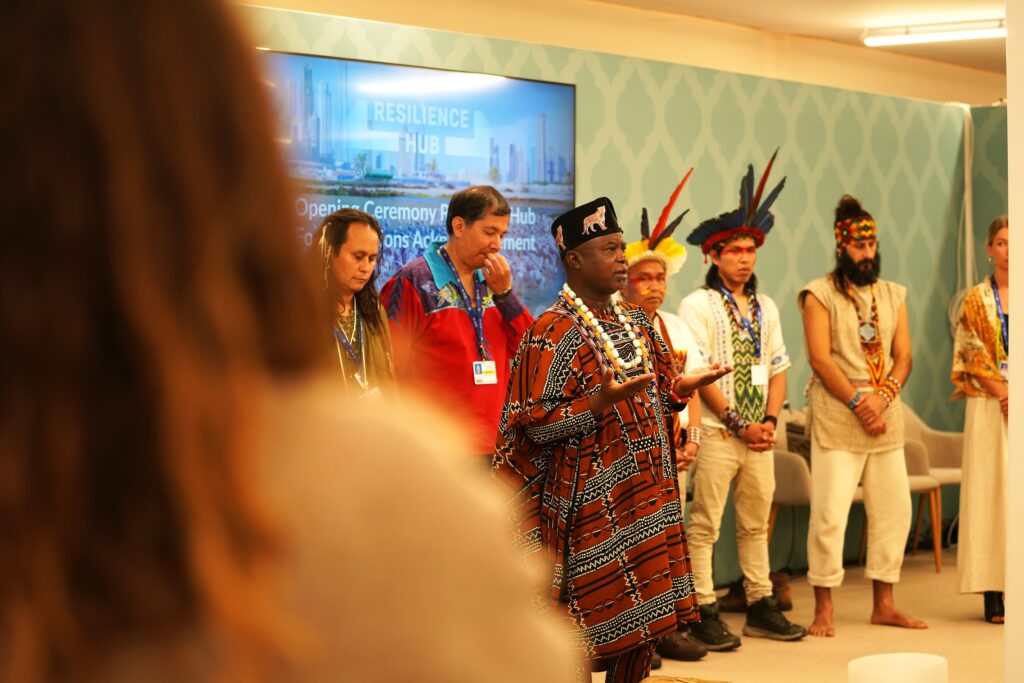Read the COP28 Synthesis Report – out now
Three years ago, I was tasked with leading a sense making and narrative building process for the first ever Resilience Hub at COP26. While previous COPs had seen an increasing focus on resilience and adaptation, prior to COP26 this had been spread across different initiatives, spaces and events inside and outside the COP. Adaptation and resilience was “everywhere but nowhere”, lacking a focal point. As the home of the Race to Resilience at COP, the Resilience Hub was designed to meet this challenge.
I set out to ask some key questions, such as: What are the calls to action and what is the supporting evidence base? Whose stories, data, and experiences are we centering? How do we prioritise and negotiate the likely trade-offs between different action pathways? What are the dominant narratives? And perhaps, most importantly – Whose narratives are we not hearing? All these helped set the framework to actively listen through hours of live sessions, analyse post-event reports and surveys and identify key messages and asks and return to do it all over again during COP27 and COP28. Let’s delve into how the dialogue on resilience has developed and transformed over these three significant milestones.
COP26: Laying the groundwork for inclusive resilience
At COP26, the emphasis was on advancing Locally-Led Adaptation (LLA). This focus highlighted the need for transformative approaches that are not only effective, but also equitable. A key takeaway was the urgent need to increase the availability and quality of finance, particularly advocating for grant-based rather than loan-based models. Sessions at the Hub also recognised the critical role of nature-based solutions (NbS) and the importance of bridging gaps between different knowledge systems and their translation into practice. Inclusivity was a strong theme, emphasising the need to prioritise the involvement of historically marginalised groups, including women, youth, and Indigenous Peoples in resilience-building efforts.
COP27: Diversification of financial actors and rethinking the governance of implementation
COP27 built upon the foundation laid at COP26 but introduced new dimensions, with a focus on interrogating the how of implementation. The conversations at the Resilience Hub felt deeper and more detailed, but the stakes – especially regarding justice and averting maladaptation – also higher. In a positive development since COP26, the private sector, financial institutions, insurers, and asset managers demonstrated progress on integrating climate risk and resilience action as core to their strategies, operations, and reporting. However, for the diversification trend to be successful, sessions at the Hub highlighted the need for inclusive decision-making processes, facilitated collaboration, and aggregation of funding for systemic rather than piecemeal approaches.
The integration of arts, heritage, and culture into resilience actions emerged as a new focal point, emphasising their importance for human development and thriving livelihoods. Another significant message was the necessity of scaling adaptation and resilience as prerequisites for addressing Loss and Damage. Hub sessions took place in a wider backdrop of a ‘patchwork of progress’ at COP, with advancements in adaptation and resilience negotiations mixed with a disappointing lack of progress on critical issues such as mitigation action to limit global warming to 1.5 degrees.
COP28: Increase in innovative resilience finance and a sharper focus on health and conflict
COP28 marked a distinct shift in focus, addressing emerging challenges in the resilience landscape. Sessions at the Hub underscored the increasing role of innovative finance approaches for resilience, pointing to the need for reforms in the wider climate finance architecture. The intersection of health, climate, and resilience emerged as a key cross-cutting theme, highlighting the need for preparedness through gender-specific and socio-cultural considerations. Against a backdrop of increasing conflict and violence, sessions highlighted the challenges they present for adaptation and resilience action, which pose the risk of reversing significant development gains.
Emergent sensemaking as a key approach to navigate complexity
The evolution of themes from COP26 through to COP28 illustrates the dynamic and complex nature of challenges related to implementing fair and effective adaptation and resilience actions. While certain themes such as finance, equity, and locally-led actions have remained central, new dimensions such as cultural aspects, health, and the impact of conflict have gained prominence over the past three years. This progression reflects a deepening understanding of what constitutes resilience and how we learn from what works and what doesn’t.
The COP28 outcomes signal that the next two years will be critical for climate action. At COP29, governments must establish a new climate finance goal and at COP30, they must come prepared with new nationally determined contributions that are economy-wide, cover all greenhouse gases and are fully aligned with the 1.5°C temperature limit.
As we look towards future COP events, it is evident that the discourse on adaptation and resilience will continue to evolve. My personal take away from this process concerns the value of reflection and emergent sense making in contexts of high uncertainty and complexity. The Resilience Hub provides a key space to take stock, discuss, reflect, and advocate, ensuring that as a global community we thoroughly weigh trade-offs and difficult decisions regarding what is of value, what we value, what we protect, and what we restore.
We hope you will (continue to) join us.
